Erin Driessen – 29 October, 2013
While allusions are readable, Robinson's concern seems to lie more with engaging with Panting's work on a formal and material plane than injecting his own content with specific local and cultural narratives. Robinson's forms are as pared down and open as Panting's, and arguably more malleable. There is no gestalt here; the end product, or the idea of one, is constantly disappearing and reappearing.
Wellington
John Panting
Spatial Constructions
Curated by Sam Cornish
Peter Robinson
Cuts and Junctures
12 October - 20 December, 2013
These two shows (the Panting upstairs, the Robinson down) have been exhibited together with correspondences in mind. The connections are intriguing, demonstrating a clear curatorial vision. The Panting exhibit consists of three large steel sculptures made between 1972 and 1974, and seven smaller works in mild steel and aluminium paint, constructed around 1972. All works are held in New Zealand public collections but have not been seen together for almost forty years. Robinson’s work was especially commissioned for the Adam’s spaces, and to coincide with the Panting exhibit. The single installation is made up of a long mat-like floor piece, a row of wall-leaning rods, several longer rods in one corner and a triangle of small wool felt pieces in another, and a triangular prism made up of more rods, horizontally-stacked.
Panting was a New Zealand-born London-based artist, who between the years of 1963, when he moved to Britain, and 1974, when he was killed in a motorcycle accident, produced a great number of diverse and innovative sculptures. Guest curator Sam Cornish’s essay is very informative regarding Panting’s inspirations and artistic development (and the accompanying monograph is beautifully illustrated). The sculptor’s work developed quickly over this period, moving from experimentation in objective modes to a sophisticated openness, and aiming to simultaneously extend and challenge figurativeness. The works exhibited here were made in the last three years of his life and demonstrate a certain consistency.
5.07 (Untitled III) [1.] and 5.12 (Untitled V) each occupy a windowed space. Sunlight has little impact on the shadows thrown by the works’ lines, an appreciated fact given the most intriguing spatial constructions are achieved through the relationships of the beams and branches to each other, not to the floor or surrounding walls. The works are pared down and open, Panting taking basic geometric forms and tearing off sides and jutting edges, interrupting the symmetry. The execution of disruption and tension is extremely elegant. My own movement around these works slowed as I tried to comprehend each angle. An imaginary line will form between one offshoot of steel and another, making for dynamic constructions. If one moves too quickly these formations are lost.
6.08 (Untitled VIII) stands between the two window spaces, occupying the foyer near the gallery entrance. This work is much more elaborate in the number of joins and short offshoots of steel. While the other two large sculptures are both grey, this one is darker and has several thicker pieces of ochre steel attached. Some of the ochre pieces appear to droop, as if shreds of muscle hanging from twisted bone. The joining screws are in pairs, gazing out like the eyes of sinewy creatures that are writhing, yet tied together. The layering of space in 6.08 is exciting; depending on which part you focus on, it looks as if one sculpture has swallowed another.
The visual and spatial impact of the smaller sculptures is fully reliant on the movement of the viewer, adding some Friedian theatrics to Panting’s innovative forms. These smaller pieces are simple yet intricate. Made up of thin lines of mild steel, they allude to signs, symbols, constellations, and game pieces. They are not maquettes but sculptures in their own right. (Cornish points out in the essay that as far as he knows, only one has a direct relation to a larger sculpture). For such small works, the extent to which Panting has created a sense of extended volume and positive space is remarkable. They still retain their internal volume and as one moves closer, then further away, or around them, certain lines and shapes thicken and thin, shifting the relationship between those internal and external volumes.
Robinson’s work not only coincides with but responds to Panting’s. His interest in Panting can be understood in the context of Robinson’s ongoing explorations into the history of modernist sculpture. His pieces here demonstrate a focus on material and the demarcation of spatial volume, the artist clearly engaging with Panting’s works as well as going back to his own roots in sculpture.
When I emailed Gallery director Christina Barton with some questions about Robinson’s participation, she explained that the dimensions of each work have been determined by the particular space it occupies. The pieces deal with measurement systems of height and length, but that is not Robinson’s primary concern. In Barton’s words, “the modus operandi is to inject ambiguity.”
The pieces that make up Cuts and Junctures are abstractly allusive in shape, colour, and configuration to traditional Maori motifs. The separate works could be seen as representations of parts of a marae: long rectangular entry path, line-up of rods as a fence (à la Auckland Airport marae), triangular roof, extra long rods as beams. These references are sufficiently abstract that his work can still be viewed as an extension of formalist concerns. He sometimes, too, steps even further in his acknowledgements of Robert Morris’s felt works and large shapes, and Carl Andre’s floor pieces. The line Robinson walks zig-zags over decades of art history, between high Modernism, post-Minimalism, and what some commentators have called the era in which we now live, “the age of authenticity.” His formalism is authentic and localised as opposed to universal.
While allusions are readable, Robinson’s concern seems to lie more with engaging with Panting’s work on a formal and material plane than injecting his own content with specific local and cultural narratives. Robinson’s forms are as pared down and open as Panting’s, and arguably more malleable - what Morris called “mutable stuff.” The separate parts of Robinson’s show are all subject to change: the long floor piece can be rolled up, the configuration of the rods will never be exactly the same, the prism made up of horizontal rods could flatten. There is no gestalt here; the end product, or the idea of one, is constantly disappearing and reappearing. This flux is felt consistently throughout a viewing of this installation. As soon as you decide it’s about form, it becomes about culture and identity politics. As soon as one form seems more prominent, it recedes again.
The feeling of back-and-forth, push-and-pull, is nowhere more evident than in the long gallery floor piece. It resembles a piano or game board, its inconsistent alternations between black, grey, and white playing across the floor as you walk alongside. There are elements of music, dialogue, space, and time. It is a visual metaphor for both Robinson’s and Panting’s practices, as they both work across different interests and respond to both past and present. Robinson especially brings the past into the present. By taking elements of more recent sculptural developments and applying them to established modes, he extends the potential of a formalist approach. Robinson’s addition of fluctuating - and therefore authentic - elements to an approach known for its claim to universal truth opens these forms to reevaluation.
Regarding the lateral arrays and horizontality of both Panting’s and Robinson’s work, there is an interesting connection to be made between sculpture and painting. Cornish has observed the relationship between Panting’s splayed sculptural lines and Jackson Pollock’s flicks and drips of paint. Panting translated from Abstract Expressionism the dramatic gesture and the sense of movement off the edges or outside the boundaries into a slower, tenser, three-dimensional space. Robinson has also slowed that movement, but especially in the long floor piece retains the flatness and self-awareness of modernist modes.
One of the most exciting aspects of each artist’s work, and so of their juxtaposition, is that sense of slow deliberate movement, of movement under tension. Robinson’s long floor piece and Panting’s 6.08 are prime examples of this. The viewer moves around or along the work and it seems to move away from us, trying to elude our view. A technological/sci-fi element is also present in each of these pieces. Panting’s 6.08 reminds me of British architect Ron Herron’s proposals for a “walking city” that he imagined in the 1960s. The white sections of Robinson’s floor piece seem to light up as we step closer to them, hailing to those silent scenes in which a lone protagonist steps into the void, the spotlight, or the future.
Barton commented on the history of artists’ engagement with sculpture as a series of “moves and countermoves.” Robinson is interested in exploring the formalist approach that was so innovated by Panting. Yet Robinson’s wish is to expand on that, moving in Barton’s words from “an autonomous, closed variety” to “one that is aware of context, history, politics.” While Panting’s constructions confront a literal, sculptural space, Robinson’s cuts and junctures occupy a more metaphorical, historical space. The late Dennis Oppenheim spoke of the idea that art is what we don’t know; everything else is art history. Robinson’s work alerts us to the idea that what is thought to be history, to be over, can be purposely un-known, cut into and joined with the present. This makes for a very interesting engagement with art and its histories, on the parts of both artist and viewer.
Erin Driessen
[1.] Regarding titles, the accompanying pamphlet advises: “John Panting did not title his works. The use of ‘Untitled’ is a curatorial attribution. Roman numerals were assigned when the works were shown in the 1976-77 memorial touring exhibition. The other numbers have been assigned during the cataloguing process accompanying the production of Sam Cornish’s monograph.”
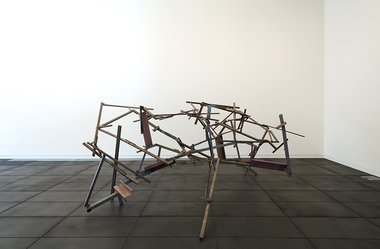
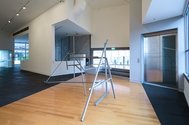
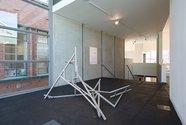
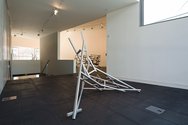
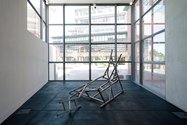
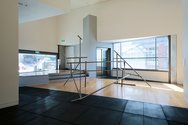
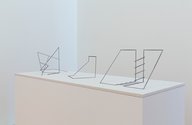
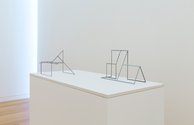
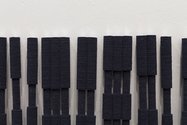
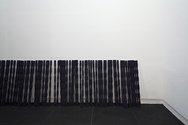



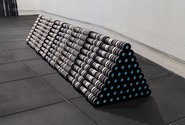

 Two Rooms presents a program of residencies and projects
Two Rooms presents a program of residencies and projects Advertising in this column
Advertising in this column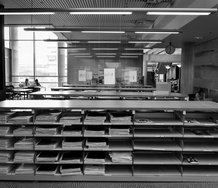
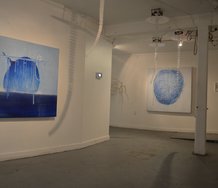
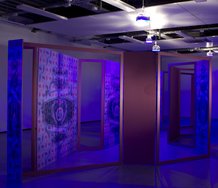
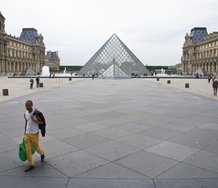
This Discussion has 0 comments.
Comment
Participate
Register to Participate.
Sign in
Sign in to an existing account.